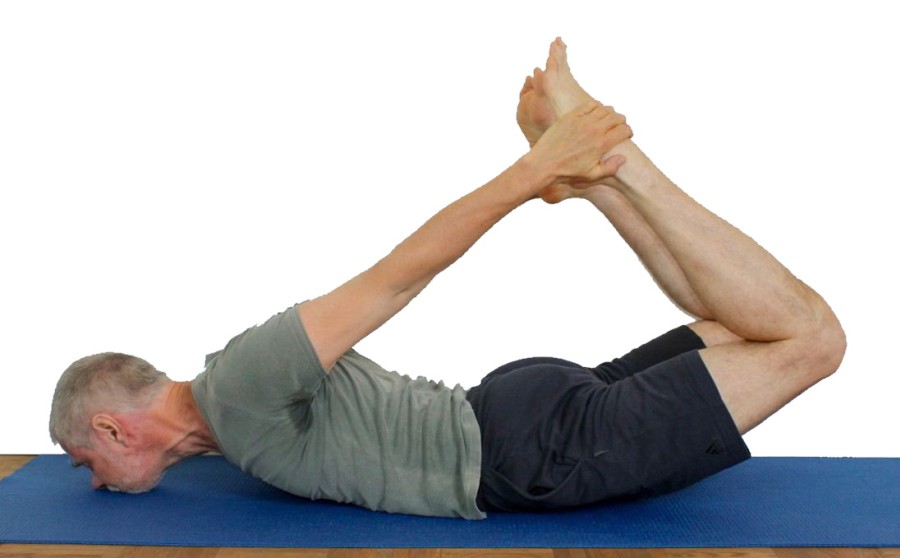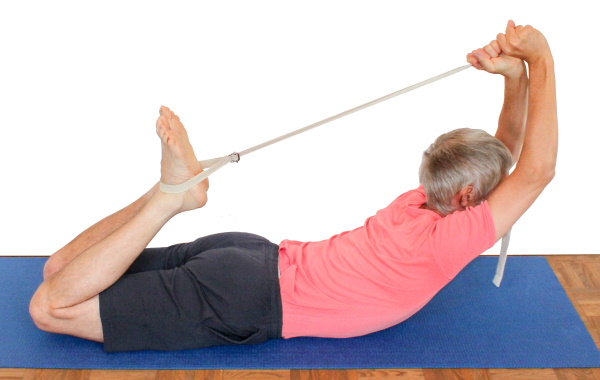yogabook / functional exercises / hip flexor flexibility test
„hip flexor flexibility test“

 instructions and details with working links as PDF for download/print
instructions and details with working links as PDF for download/print
Feedback: We’d love to hear what you think about this description, give us feedback at:
postmeister@yogabook.org
Last modified: 30.12.2018
Name:
trivial name: hip flexor flexibility test
Level: FA
- classification
- contraindications
- effects
- preparation
- follow-up
- derived asanas
- similar asanas
- diagnostics
- instructions
- details
- variants
Classification
classic: diagnostics
Contraindication
Due to the possible extension/hyperlordosis of the lumbar spine, the pose poses a difficulty for people with facet syndrome, spondylolisthesis and spinal canal stenosis; known pain can reoccur here. If this is not the case and the pose is only performed briefly to assess the condition of the hip flexors, this is not a compelling contraindication, but the pose must be cancelled at the first sign of pain.
Effects
Preparation
No preparatory exercises are given for this functional exercise.
Follow-up
Derived asanas:
Similar asanas:
Diagnostics (No.)
Variants:
Instructions
- The performer lies in prone position on the floor, bends his knees and grabs the ankles with his hands to pull his knees up from the floor with the strength of his arms.
- The supporter sits in a straddle on his bottom behind the performer (at the foot side) and presses the performer’s knees together with his thighs so that he cannot let them fall further than hip-width apart.
- When the maximum height of the knees is reached, the supporter measures how far the knees are vertically from the floor in hand thicknesses (thickness of the base joints, from palmar to dorsal) or hand widths (width of the hand above the base joints 2-5, from radial to ulnar) or a combination of these.
- The measurement is taken for each side. A side-by-side comparison is also important, as different flexibility of the hip flexors can cause pelvic torsion.
Details
- The aim of the pose is only to raise the two (left and right) distance measurements of the knees perpendicular to the floor. The pose should not be held beyond this. Of course, this is a pre-scientific procedure, but it is very practicable and provides an important rough diagnostic statement with sufficient reliability and accuracy. In addition, the resources to be used (1 supporter) and the time required are very low. Therefore, every newcomer to yoga practice should undergo this test, especially if poses such as upface dog, hip opener 1, ustrasana, urdhva dhanurasana indicate that hip flexibility in the direction of extension is rather questionable.
- The pelvis should remain as close to the floor as possible and the use of the glutes for extension in the hip joints is explicitly permitted. The upper body should not lift significantly so that the pelvis does not partially lift and distort the result.
- The knees should remain at hip width (not pelvis width!). This often has to be enforced with (possibly very strong) use of the supporter’s adductors. Particularly if the hip flexors are not very flexible, the thighs (i.e. the knees) are massively forced to deviate into abduction. As a rule of thumb, hip width means that a hand just fits between the muscular parts of the inner thighs, i.e. they noticeably pinch the hand.
- Discomfort in the lumbar spine is not uncommon with this test and cannot always be avoided despite using the glutes. For this reason, and because the stretching benefit of the pose itself is quite limited due to the relatively weak force acting on the hip flexors, the pose should be resolved immediately after the two distance measurements on the left and right have been taken.
- This test measures the relevant hip flexors as a functional unit. Although the adductors also have a hip-flexing effect, these are of secondary importance for powerful wide flexion in the hip joint and are not very restrictive for extension without abduction. The m. psoas major, m. iliacus and, even more due to the bent knees, the m. rectus femoris (biarticular head of the quadriceps) are relevant. The m. rectus femoris is often the most restrictive here, more so than the hip flexors located inside the pelvis (iliopsoas), as the knee joints are very widely flexed. If the flexibility of the iliopsoas is to be assessed with this test set-up, the flexion of the knee joint must be limited to around 90°. The knees can then only be passively lifted off the floor by the supporter/examiner. Another test, although its specificity is not ideal, is the hip opener 1. In this test, the pelvis is lowered as far as possible with the rear leg extended, which is equivalent to an extension in the corresponding hip joint and provides a good indication of the degree of extension if – and this is a real prerequisite or limitation – the hip extensors are sufficiently flexible not to hinder the lowering of the pelvis (front leg). Other poses to assess the flexibility of the iliopsoas are, for example, the warrior 1 pose, back arch, purvottanasana and ustrasana.
- The test result naturally requires interpretation:
- if a „hip triangle“ occurs, i.e. one or more hands can be pushed (one on top of the other) between the floor, thigh and SIAS (anterior superior iliac spine) without resistance, the hip flexors are pathologically shortened, postural damage has almost certainly occurred, this means urgent action is required.
- If there is no hip triangle and the knees are not at a distance from the floor, the hip flexors are also pathologically shortened and postural damage has probably occurred or will inevitably occur.
- If there is no hip triangle and the distance between the knees and the floor is less than a hand’s width, this is probably a shortening relevant to everyday life, which can still be compensated for with postural awareness and strength of the extensors of the hip joint (hamstrings or gluteus maximus in particular, depending on the force required), but will probably rarely occur in everyday life(!).
- If there is no hip triangle and the distance between the knees and the floor is greater than a hand’s width, the hip flexors are probably sufficiently flexible for everyday postures. However, a hollow back can still occur as a result of poor posture and a lack of postural awareness. A check at certain intervals and posture awareness is sufficient for the time being.
- If the knees cannot be lifted off the floor, a so-called „hip triangle“ (see above) can occur, which allows one or more hands to be placed on top of each other between the SIAS and thighs on the one hand and the floor on the other. This hip triangle and the number of hands that are can be inserted is additional information about the extent of the shortening of the hip flexors, the distance between the knees is then automatically zero.
- The hip flexors are very important for back health. If they are not sufficiently flexible – regardless of postural awareness – the result is a chronic hollow back (to be precise: when standing with more or less stretched knees). In the long term, the muscles of the lumbar spine will increase in mass and tension (!) and the pressure on the intervertebral discs will also increase, especially in forward-bending movements and postures, which, depending on other favourable factors such as
- lack of exercise
- frequent lifting of heavy loads
- asymmetries in the musculoskeletal system
- disturbed or shortened sleep, especially in unfavourable sleeping positions such as lying on your side or stomach
- Unfavourable levers and postures during movements at work, sport and leisure activities
- Frequent lifting that is not „back-friendly“
the first signs of damage will appear at some point:- Protrusion (protrusion with the annulus fibrosus, the outer fibrous ring of the intervertebral discs, still intact), often followed by
- Prolapse (rupture of the bulging annulus fibrosus with squeezing of material from the nucleus pulposus to the outside of the disc)
- Further damage such as sequestration (squeezing off part of the disc)
The repeatedly recommended training of the abdominal muscles does help a little to straighten the pelvis, although it must be remembered that the abdominal muscles are less powerful than the hip extensors, but this happens at the expense of more difficult inhalation and increased overall pressure on the intervertebral discs!
So, there is no substitute for promoting the flexibility of the hip flexors to a sufficient degree together with sufficient postural awareness!
- Knee complaints are not uncommon with the high degree of flexion of the knee joint required during the test. This is all the more likely to occur if the rectus femoris in particular is less flexible, above all because of the shortening-induced pressures in the joint.
- The following orthopaedic tests provide further information on the shortening and corborate:
- See also the exploration for the movement of the pelvis and iliopsoas: press the spine against the wall and tilt the pelvis.
Known problems that can occur even when performed correctly
Knee pain during the exercise
As already described above, knee pain cannot be completely ruled out in the case of low flexibility and also in cases of pathologically altered knee joints. If the test is performed quickly, this should be tolerable.
Complaints in the lumbar spine
Depending on the constitution and any previous damage to the lumbar spine, discomfort may occur in the lumbar spine. As long as it is not neuroradicular pain, this should be tolerable if the test is performed quickly.
Variants
with belt

Instructions
- Take the pose as described above, but pull with a belt on your feet instead of directly with your hands.
Details
- This variation is more for clarification than for any other direct benefit. In cases where the performer cannot reach the feet with the hands, this rules out the proportion argument and proves that the inability to grasp the feet is due to flexibility restrictions in the hip flexors (and only secondarily in other parts such as the back and shoulder joints in terms of possible retroversion). The use of a belt, if this appears necessary, will hardly improve the ability to lift the knees. In particular, it should be checked whether a hip triangle (see above) is present.
